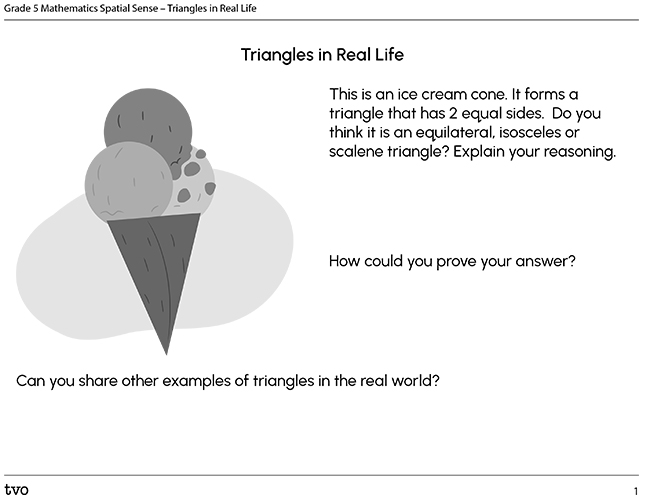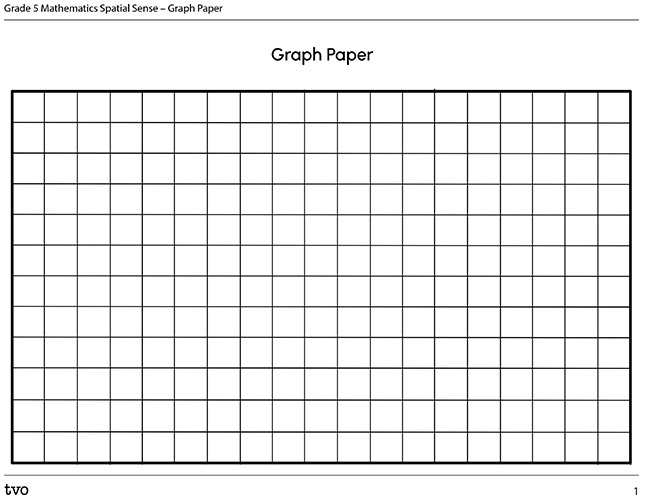Minds On
Triangles in the real world
Triangles can be found in so many places. But if we examine them closely, we will notice not all triangles are the same.
Consider the pizza slice, a ramp, and a traffic sign. They are 3 different types of triangles. What differences do you notice between them? Record your thoughts using a method of your choice.
Action
Classifying triangles
No matter what shape or size, all triangles contain three angles, or three places where lines intersect to create an angle.
There are three ways to classify a triangle by the number of equal sides it has.
- An equilateral triangle has all three sides the same length.
- An isosceles triangle has two sides that are the same length.
- A scalene triangle has no sides that are the same length.
There are also three ways to classify a triangle by the number of equal angles it has.
- In an equilateral triangle, all three angles are equal.
- In an isosceles triangle, there are two equal angles.
- In a scalene triangle, all the angles are different measurements.
Press the ‘Tip’ button to access a tip about how triangles are labelled.
Note: You will come across triangles that are labelled. If there are sides that are labelled with the same mark (a line through the side called a hatch mark) are the same length. Angles that are labelled with the same mark in them (often a circle) are the same size.
Classifying triangles by number of equal sides or number of equal angles. There are 3 different types of triangles. First is an equilateral triangle. There is a single hatch mark (line) through each of the three sides and a small circle in each of the angles to show that they have equal sides/angles. Second is an isosceles triangle. There is one hatch mark on one side and two hatch marks on each of the other two sides to show two sides have the same length and one side has a different length. There are circles in two of the angles to show they are equal. The two little circles are always across from the equal sides. Third is a scalene triangle. There is one hatch mark on one side, two hatch marks on a second side and three hatch marks on the third side. There are no circles in the angles. This is to show that there are no equal sides or angles.
There are more ways to classify a triangle! We can also use the angles inside a triangle to classify it.
- An acute triangle has all angles inside of it that are less than 90 degrees.
- A right triangle has one angle that is exactly 90 degrees.
- An obtuse triangle has one angle that is greater than 90 degrees.

Solving for missing information in a triangle
Now, if we have some measurements of a triangle, but not all of them, we can still solve for missing information.
If we had two inside angles and one missing angle as in the description provided, then we can still find the missing angle by using the two known angles.
Here is an example of how:

Angle C is missing, so to find it without using a protractor we can simply subtract angle A and angle B from 180°.
This will get us our answer for the missing angle C.
Press the ‘Answer’ button to access the step-by-step solution to solving missing angle C.
C = 180° - A - B
C = 180° - 37° - 24°
C = 119°
To check if it is correct, we can add angle A, plus angle B, plus angle C.
The answer should be 180°.
Press the ‘Answer’ button to access the step-by-step process to checking your answer.
A + B + C
= 37° + 24° + 119 °
= 180°
Task 1: Missing angles in triangles
There are 2 roofs of 2 houses. In order for a roof to be perfectly centered and symmetrical, the bottom two angles of a triangle must be the same.

The first roof has an angle of 45° and another angle of 70°. There is an x to mark the last angle, which is missing.
The second roof has one angle of 110° and the other two angles are missing. They are each marked with an x.
Now that you know how to solve and measure angles in a triangle with some angles missing, think about how you might solve to find the missing angles in these questions.
Find the measures of the unknown angles and determine which roof is perfectly centered and symmetrical. Record your ideas in a notebook or a method of your choice.
You may check your answers with the following fill-in-the blanks.
Press the ‘Answer’ button to access a step-by-step solution to compare your answer to.
Subtract the known angles from 180° to find the missing angles of the roof.
Roof 1:
x = 180° - 45° - 70°
x = 65°
The missing angle in roof 1 is 65°.
Roof 2:
180° -110° = 70°
The two unknown angles on roof 2 are equal, so we divide 70° by 2 to get the value of each angle.
x = 70° ÷ 2 = 35°
The missing angles in roof 2 are both 35°
The second roof is the symmetrical one since both angles are the same in the second triangle.
Task 2: Creating triangles with specific side lengths or angle sizes
Now, we are going to learn how to create triangles with specific side lengths or angle sides. Let’s explore this video to find out how.

Using what you learned in the video, draw these triangles. You will need a ruler and a protractor. Record your work using a method of your choice.
- A triangle with sides 6 cm, 8 cm and 10 cm.
- A triangle with a 7 cm side. An angle off one end of the 7 cm side is 30° and the angle off the other end of the 7 cm side is 65°.
How would you classify these two triangles?
Press the ‘Answer’ button to access a solution to compare your answer to.

The first triangle with 6 cm, 8 cm, and 10 cm sides seems to be a right triangle. It can also be classified as a scalene triangle because all the sides have different length.
The second triangle with one side that is 7 cm in length and has two angles of 30° and 65° can be classified as an acute and scalene triangle.
Consolidation
Task 1: Triangles in real life

Think about how you would classify a triangle with two equal sides (an ice cream cone). Do you think it is an equilateral, isosceles, or scalene triangle?
Explain your reasoning. How could you prove your answer?
Record your thoughts in the graphic organizer, your notebook, or a method of your choice.
Task 2: Independent triangle construction
Create an example of an isosceles, equilateral, and scalene triangle. Be sure to indicate the measurements of all sides. You may use the graph paper provided or another method of your choice to complete the triangles.
Reflection
As you read through these descriptions, which sentence best describes how you are feeling about your understanding of this learning activity? Press the button that is beside this sentence.
I feel...
Now, record your ideas using a voice recorder, speech-to-text, or writing tool.
Connect with a TVO Mathify tutor
Think of TVO Mathify as your own personalized math coach, here to support your learning at home. Press ‘TVO Mathify’ to connect with an Ontario Certified Teacher math tutor of your choice. You will need a TVO Mathify login to access this resource.
TVO Mathify (Opens in a new tab)



